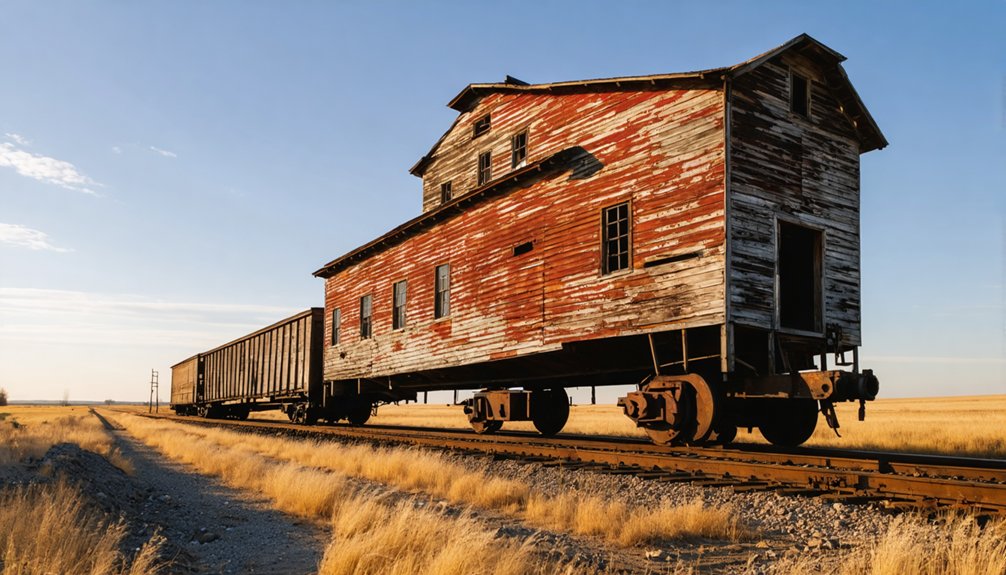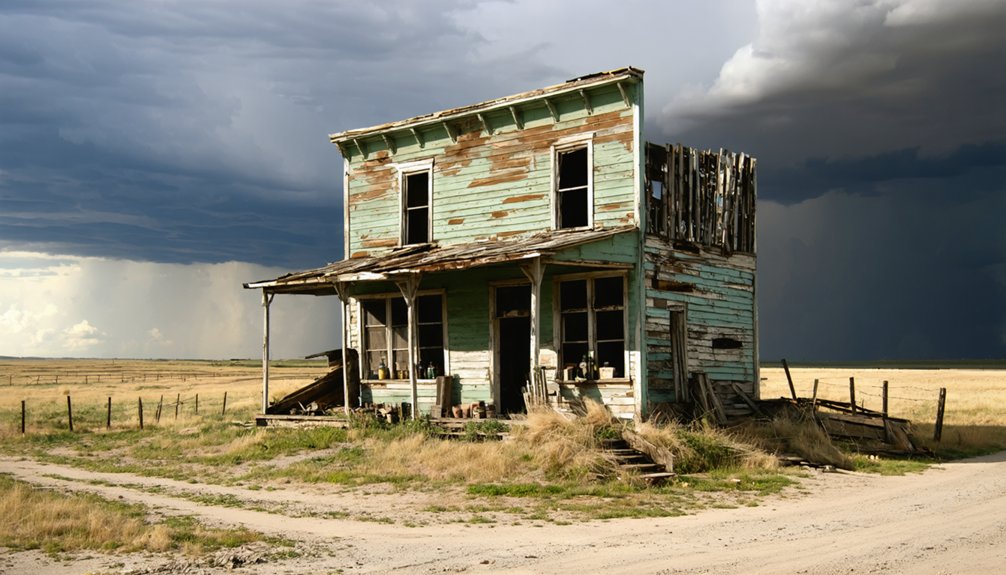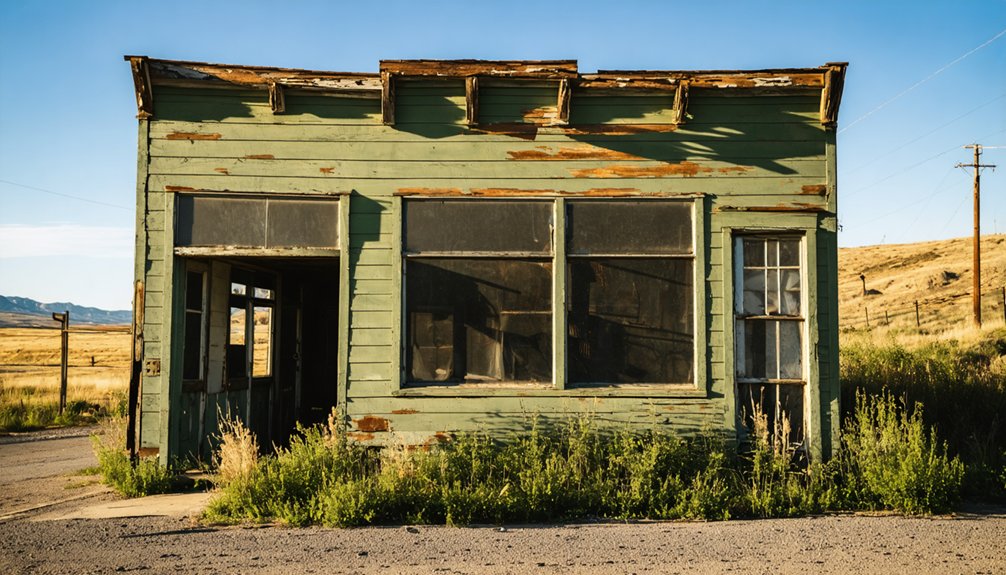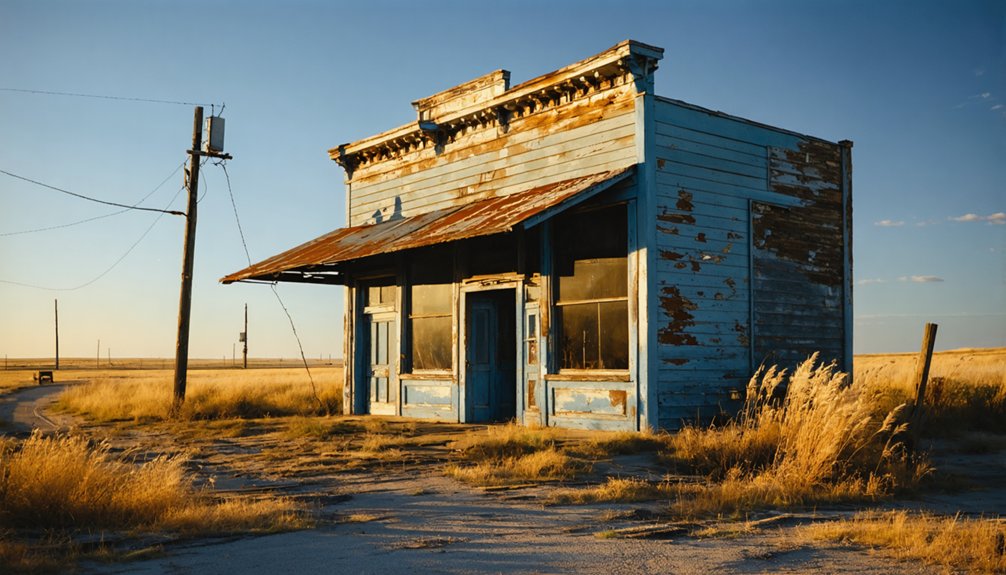You’ll find Runkel nestled in South Dakota’s Black Hills, where railroad contractor George Runkel established this mining settlement in 1889. The town flourished as a crucial hub connecting mining operations through rail service, with George Runkel managing both railroad development and silver mining ventures. Despite its promising start, Runkel’s prosperity was short-lived – a devastating boiler explosion in 1895, coupled with dwindling mineral deposits, led to its abandonment. The town’s remaining foundations tell a compelling story of boom-and-bust frontier ambitions.
Key Takeaways
- Founded by George Runkel in 1889 near Elk Creek Station during the Black Hills gold rush era as a mining and railroad town.
- Peaked with approximately 100 residents and thrived through gold mining, silver deposits, and lumber operations in the 1880s-1890s.
- Railroad connections made Runkel a vital hub for ore transport and supplies until route changes by Chicago and Northwestern Railway.
- A devastating boiler explosion in 1895, combined with declining mineral deposits, triggered the town’s eventual abandonment.
- Only foundations and walls remain today, with no formal preservation efforts, making it an authentic ghost town exploration site.
The Runkel Family Legacy and Railroad Connection
While many ghost towns dot the landscape of South Dakota, Runkel’s story began with George Runkel‘s ambitious railroad ventures in the 1880s. His railroad legacy started in Crystal Falls, where he partnered with Col. J.H. Howe to expand rail service by 1882.
George Runkel’s vision transformed South Dakota’s landscape through pioneering railroad development alongside Col. J.H. Howe in the 1880s.
You’ll find Runkel’s influence grew as he moved to South Dakota’s Black Hills region in 1884, establishing himself as a prominent railroad contractor and sawmill operator. Working with a crew of 300 to 400 men, he demonstrated the same work ethic that had driven his earlier successes in railroad construction. Like his father who expanded the Chicago and Northwestern Railway, Runkel understood the importance of strategic rail development.
The Runkel legacy deepened when he filed land claims near Elk Creek Station in 1889, founding the town that would bear his name. His railroad expansion efforts connected essential mining operations from Lead through Elk Creek Station to Runkel, while simultaneously overseeing mines and timber operations.
This strategic development positioned Runkel as a key figure in the region’s transportation infrastructure and economic growth.
Birth of a Mining Boom Town
Runkel’s establishment followed George Runkel’s early railroad construction work that connected essential mining operations in the Black Hills region during the 1874 gold rush era.
You’ll find that the town grew from a small mining camp into a bustling settlement after Runkel became superintendent of the Greenwood Gold Mining Company, capitalizing on both silver deposits and timber resources. Similar to other mining operations of the time, workers relied on pick and shovel methods before more advanced techniques were implemented.
The Runkel family’s influence expanded through their railroad connections, which proved critical for transporting ore and supplies while establishing the town as a significant hub in the Black Hills mining network.
Railroad Influence and Growth
During the early 1880s, George Runkel’s expertise in railroad development shaped the birth of a new Black Hills mining town. After proving his capabilities with the Chicago & Northwestern Railway in Michigan, he arrived in the Black Hills by 1884 as a railroad contractor. His vision for railroad expansion materialized when he filed land claims in 1889, establishing the town that would bear his name.
You’ll find Runkel’s influence extended beyond just laying tracks. He operated a sawmill to supply timber for both railroad and town construction, while championing essential rail routes connecting Lead through Elk Creek Station to Runkel and Piedmont. The area’s development mirrored the significant railroad network growth that characterized the Black Hills region throughout the 1880s.
These rail connections transformed the area’s economic growth, enabling efficient transport of mining supplies, equipment, and passengers. The railroad station became a significant hub for commerce, communication, and community life.
Mining Camp Beginnings
As the promise of mineral wealth drew placer miners to the Black Hills in 1875, a wave of prospectors established early mining claims that would shape Runkel’s future.
George Runkel arrived in 1884, initially working as a railroad contractor before becoming superintendent of the Greenwood Gold Mining Company. Like the nearby Dakota School of Mines, established in 1885, the area became an important hub for mining education and innovation.
Through shrewd resource management, Runkel secured control of mines previously deemed worthless, discovering they contained valuable silver deposits alongside timber resources.
While gold proved scarce, the camp’s economic foundation diversified into silver mining and lumber operations.
You’ll find the early mining challenges weren’t just about extracting ore. Legal battles erupted over mineral rights, particularly involving patents registered by Flormann. Like many of the over six hundred ghost towns that would eventually dot the Black Hills, the settlement faced uncertain beginnings.
Chicago investors, connected through Runkel’s business network, provided essential financial backing for the growing mining settlement.
Runkel Family Settlement History
The fall of 1884 marked George Runkel’s strategic entry into the Black Hills region, where he’d initially work as a railroad contractor while quietly evaluating the area’s development potential.
By 1889, he’d begun filing timber and homestead claims, establishing what would become the town bearing his name. Like his noble ancestors who built the Castle of Runkel in 1059, George sought to establish a settlement that would protect and support the surrounding community.
The Runkel family’s economic contributions quickly expanded beyond land holdings. They supervised local mining operations, ran an important lumber business supporting the mines, and pushed for essential transportation infrastructure.
Their efforts to extend railroad access through the Black Hills and build new roads via Tilford and Elk Creek Station proved significant for the settlement’s growth, despite challenges like A.M. Morse’s controversial road tolls.
Through their integrated approach to mining, lumber, and transport, the Runkels transformed their settlement into a thriving boom town.
Daily Life in Early Runkel
Life in early Runkel centered around the demanding rhythms of mining and lumber work, with approximately 100 residents occupying simple wooden homes during the town’s peak period.
You’d find community gatherings at the local dance halls and saloons, where miners could unwind after grueling shifts. The post office served as a crucial hub for news and correspondence, while small chapels doubled as community centers. Just like at the Gaslight Restaurant, these social spots were vital to maintaining community spirit.
Like in nearby old Capa Hotel, accommodations were basic but essential for traveling workers and merchants.
Daily survival meant confronting harsh realities: unreliable steam boilers, basic sanitation, and the constant threat of disease outbreaks.
Economic challenges loomed as mining yields fluctuated, affecting everyone from store owners to sawmill workers. You’d need to rely on sporadic rail and wagon deliveries for supplies, while dirt roads connected you to neighboring camps and essential services.
Railroad’s Impact on Town Development

While establishing essential transport links throughout the Black Hills region, railroad contractor George Runkel catalyzed his namesake town’s founding in the late 1880s.
You’ll find his pioneering spirit reflected in the railroad expansion that transformed this remote area, beginning with his land claims in 1889.
The railroad’s economic transformation of Runkel centered on three key developments:
- Completion of the rail line from Lead through Elk Creek Station to Piedmont by 1890
- Integration with local mining operations, where Runkel served as superintendent
- Development of supporting industries like sawmills that relied on efficient rail transport
You can trace Runkel’s earlier success in railroad development to Crystal Falls, where he’d already proven his ability to connect isolated communities through crucial rail infrastructure. Like many South Dakota settlements, the town followed a T-shaped layout pattern with its commercial district perpendicular to the tracks.
The Peak Years of Prosperity
During Runkel’s heyday, you’d find a vibrant community of around 100 residents sustained by profitable mining operations and sawmill activities.
You could witness daily life centered around essential businesses like general stores and blacksmith shops, while social gatherings at dance halls strengthened community bonds.
The town’s prosperity during this period was reflected in its ability to maintain vital services, including one of the earliest post offices in the Black Hills region.
Mining and Railroad Wealth
Following his arrival in South Dakota, James Runkel transformed the struggling Greenwood Gold Mining Company into a profitable enterprise by recognizing the mine’s true potential in silver rather than gold.
After resolving mineral rights disputes and legal challenges from Daniel Miles, Runkel’s economic diversification strategy proved successful.
As superintendent of the Chicago, Bellevue, and Western Railroad, Runkel leveraged transportation networks to maximize mining profits.
You’ll find his influence extended through:
- Integration of mining and rail operations to reduce shipping costs
- Strategic timber harvesting from mining lands to support infrastructure
- Development of multiple mining camps along railroad routes
Through his Chicago connections, Runkel secured investors while maintaining operational control, even after selling properties.
His combined mining-railroad ventures accelerated regional growth and established lasting economic foundations throughout the Black Hills.
Daily Life During Boom
As Runkel’s economic prosperity reached its peak, the town’s population swelled with an influx of miners, merchants, and their families seeking new opportunities in the Black Hills.
You’d find general stores, saloons, and boarding houses catering to the diverse workforce, while blacksmiths and livery stables kept the town’s equipment running.
Life wasn’t easy – you’d face harsh winters, disease outbreaks, and the constant risk of mining accidents.
The transient lifestyle meant neighbors came and went, but community gatherings, dances, and holiday celebrations helped forge connections.
In your free time, you might’ve enjoyed gambling at the saloons, hunting in the surrounding wilderness, or attending makeshift religious services.
While successful merchants and mine owners lived in proper frame houses, most workers made do with basic cabins or tents.
Factors Leading to Abandonment

The decline and eventual abandonment of Runkel stemmed from multiple interconnected factors, with the collapse of the mining industry serving as the primary catalyst.
You’ll find that Runkel’s economic vulnerability became apparent as gold deposits dwindled, triggering widespread population decline and business closures.
The town’s fate was sealed by:
- The Chicago and Northwestern Railway’s shifting routes, which isolated Runkel from essential transportation networks
- A devastating 1895 boiler explosion that dealt a severe blow to local industry and community morale
- The town’s inability to diversify beyond mining, leaving it defenseless against economic downturns
The exodus accelerated as young families departed, schools closed, and remaining businesses shuttered.
Without sustainable infrastructure or alternative industries, Runkel couldn’t adapt to changing times, ultimately leading to its abandonment.
What Remains Today: A Vanished Settlement
While time has erased most traces of Runkel’s once-bustling streets, today you’ll find only scattered remnants of this former mining settlement. The site’s deteriorated foundations and partial walls peek through native vegetation, with no intact commercial structures remaining.
For ghost town exploration enthusiasts, the area offers an authentic abandoned atmosphere, though you’ll need to navigate unmarked dirt paths and overgrown fields to discover its historical significance.
The property, which was listed for sale in 2011, never saw planned redevelopment into a museum. Now, you’ll encounter a landscape that’s largely returned to nature, with agricultural fields surrounding the former townsite.
Without formal preservation efforts or guided access, Runkel’s physical remains continue to fade, serving as a silent reflection of South Dakota’s shifting rural fortunes.
Preserving Runkel’s Place in Black Hills History

Despite limited physical remains, preserving Runkel’s historical legacy remains essential for understanding Black Hills development during the gold rush era.
You’ll find that historical documentation efforts focus on capturing the town’s rich heritage through digital archives and storytelling initiatives.
Here’s how you can engage with Runkel’s preservation:
- Join local historical societies working to document the town’s mining and lumber industry connections
- Participate in community engagement programs that collect oral histories and photographs
- Support partnerships between preservation groups and regional organizations that maintain Black Hills heritage
Through these preservation efforts, you’re not just saving stories – you’re keeping alive the spirit of freedom and opportunity that drew settlers like George Runkel to establish this important railroad town during the region’s dynamic growth period.
Frequently Asked Questions
What Was the Total Population of Runkel at Its Peak?
While exact Runkel demographics weren’t recorded, you’ll find evidence suggesting the peak population reached 50-100 residents before Runkel’s decline, fitting patterns of similar Black Hills ghost towns during their brief existence.
Were There Any Major Crimes or Notable Lawmen in Runkel?
You won’t find tales of wild outlaws or legendary lawmen in Runkel’s history. The town’s biggest incident was actually an industrial accident – a deadly boiler explosion in 1895 that claimed two lives.
Did Any Famous Historical Figures Ever Visit Runkel?
You won’t find any records of famous visitors in Runkel’s history. Despite its historical significance as a railroad and mining town, there’s no evidence that any notable figures ever stopped there.
What Types of Businesses and Services Existed in Runkel Besides Mining?
You’d find Runkel’s C.O.D. Store selling general merchandise, a sawmill run by George Runkel, one of the region’s first post offices, and entertainment venues like dance halls serving miners.
Were There Any Schools or Churches Established During Runkel’s Existence?
You won’t find records of formally established schools or church activities in Runkel’s history. Residents likely traveled to nearby towns for education and worship during the mining town’s existence.
References
- https://historicalsturgis.com/remembering-the-town-of-runkle/
- https://www.powderhouselodge.com/black-hills-attractions/fun-attractions/ghost-towns-of-western-south-dakota/
- https://www.sdpb.org/rural-life-and-history/2023-08-21/some-black-hills-ghost-towns-and-their-origins
- https://www.sdhspress.com/journal/south-dakota-history-2-2/some-black-hills-ghost-towns-and-their-origins/vol-02-no-2-some-black-hills-ghost-towns-and-their-origins.pdf
- https://www.youtube.com/watch?v=_0WNYsFLSLA
- https://www.blackhillsbadlands.com/blog/post/old-west-legends-mines-ghost-towns-route-reimagined/
- https://en.wikipedia.org/wiki/List_of_ghost_towns_in_South_Dakota
- https://en.wikipedia.org/wiki/Firesteel
- https://www.youtube.com/watch?v=De3wGn9KDkg
- https://www.ironmountaindailynews.com/news/local-news/2017/02/runkel-led-railroad-expansion-to-crystal-falls/



